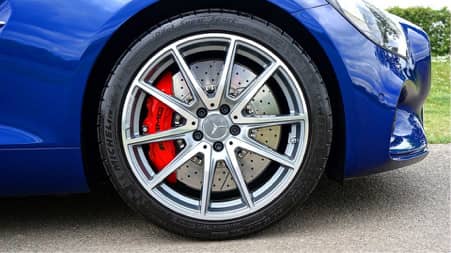High Performance Tyres
Most premium manufacturers offer a range of high performance tyres that are designed to provide exceptional handling and superior grip at high speeds. High performance tyres are often developed by manufacturers who have a long and successful history of engineering tyres for the motorsports sector, drawing on their experience.
High Performance Tyres Advantages
High performance tyres offer a premium sports performance which cannot be rivalled by other types of tyres. Designed to provide excellent handling, precise steering response and high speed capabilities, high performance tyres are the best choices if you demand a superior drive at high speed, there are several advantages which include.
Shorter stopping distances
The superior grip of performance tyres also translates to shorter stopping distances, meaning you can brake more effectively, which is crucial for safety, particularly in emergencies.
Enhanced grip
High-performance tyres typically have specialised rubber compounds and tread designs that provide superior traction, especially in dry conditions. This improved grip allows for better handling and cornering at higher speeds.
Better performance in wet conditions
Many high-performance tyres are engineered with special tread patterns and compounds that effectively channel water away from the tyre's contact patch, reducing the risk of aquaplaning and improving wet-weather grip compared to standard tyres.
Enhanced aesthetics
High-performance tyres often have a sporty appearance with aggressive tread patterns and sidewall designs, which can enhance the overall aesthetics of your vehicle.
Increased stability at high speeds
High-performance tyres are often constructed with stiffer sidewalls and reinforced internal structures to provide greater stability, especially at high speeds. This stability reduces the risk of sidewall flexing or tyre deformation, resulting in a smoother and more controlled driving experience.

High Performance Tyres Drawbacks
Higher cost
As these tyres are the product of meticulous research and testing, the associated price tag, can be fairly steep.
Reduced tread life
Another drawback of choosing to fit high performance tyres is that they can wear more rapidly than other types of tyres, such as energy saving tyres.This is because the specialist compound used has been designed for speed rather than resistance. Driving at high speeds will also cause additional wear on high performance tyres.
Vulnerability to damage
The softer rubber compounds used in performance tyres may make them more susceptible to damage from road hazards such as potholes. This vulnerability to damage could result in punctures, or sidewall damage, necessitating more frequent tyre replacements.
Frequently Asked Questions
High performance tyres offer higher speed capabilities and sportier handling than other tyres and they are ideal for dynamic drivers. High performance tyres are constructed using specialist compounds that are designed to offer high levels of grip so that they can provide impressive short braking distances and precise handling.
High performance tyres are best suited for dynamic drivers who demand stability and precision at high speed from their tyres. They may be less suitable for drivers who prioritise fuel consumption, tyre life or those who mainly drive short distances in predominantly urban areas.
For further information on high performance tyres, contact your local Setyres branch where one of our tyre specialists will be happy to provide further advice and guidance.
Tyre size plays a crucial role in determining the performance characteristics of high performance vehicles. However, it's essential to strike a balance between performance, ride comfort, and practicality when selecting tyre sizes, taking into account factors such as driving conditions, vehicle specifications, and personal preferences.
You will normally find a sequence of letters/numbers on the outer wall of your tyre, which looks something like this:
206/55 R16 91V
Broken down, here is what the sequence means
206 (Tyre Width in mm)
/55 (Aspect Ratio - In simpler terms, this is the height of the sidewall as a percentage of the tread width e.g. in this case, the sidewall is 55% of the tread width).
R (Radial Construction - The expected construction for all modern tyres).
16 (Rim Diameter - In inches)
91 (Load Index - This indicated the load-carrying capacity of a tyre. The higher the number, the greater its load-carrying capacity is).
V (Speed Rating - Shows the maximum speed a tyre can reach when at full load. Described in letter form, each letter’s corresponding speed in mph can be found below).
N: 87mph, P: 93mph, Q: 99mph, R: 106mph S: 112mph, T: 118mph, U: 124mph, H: 130mph, V: 149mph, Z: 150+mph, W: 168mph, Y: 186mph
You should generally find a tyre that either matches or exceeds your car’s optimum speed – failing to do so can invalidate your insurance.
Tyre size can influence a vehicle's fuel efficiency. Larger, wider tyres typically have higher rolling resistance which can decrease fuel economy compared to smaller, narrower tyres.